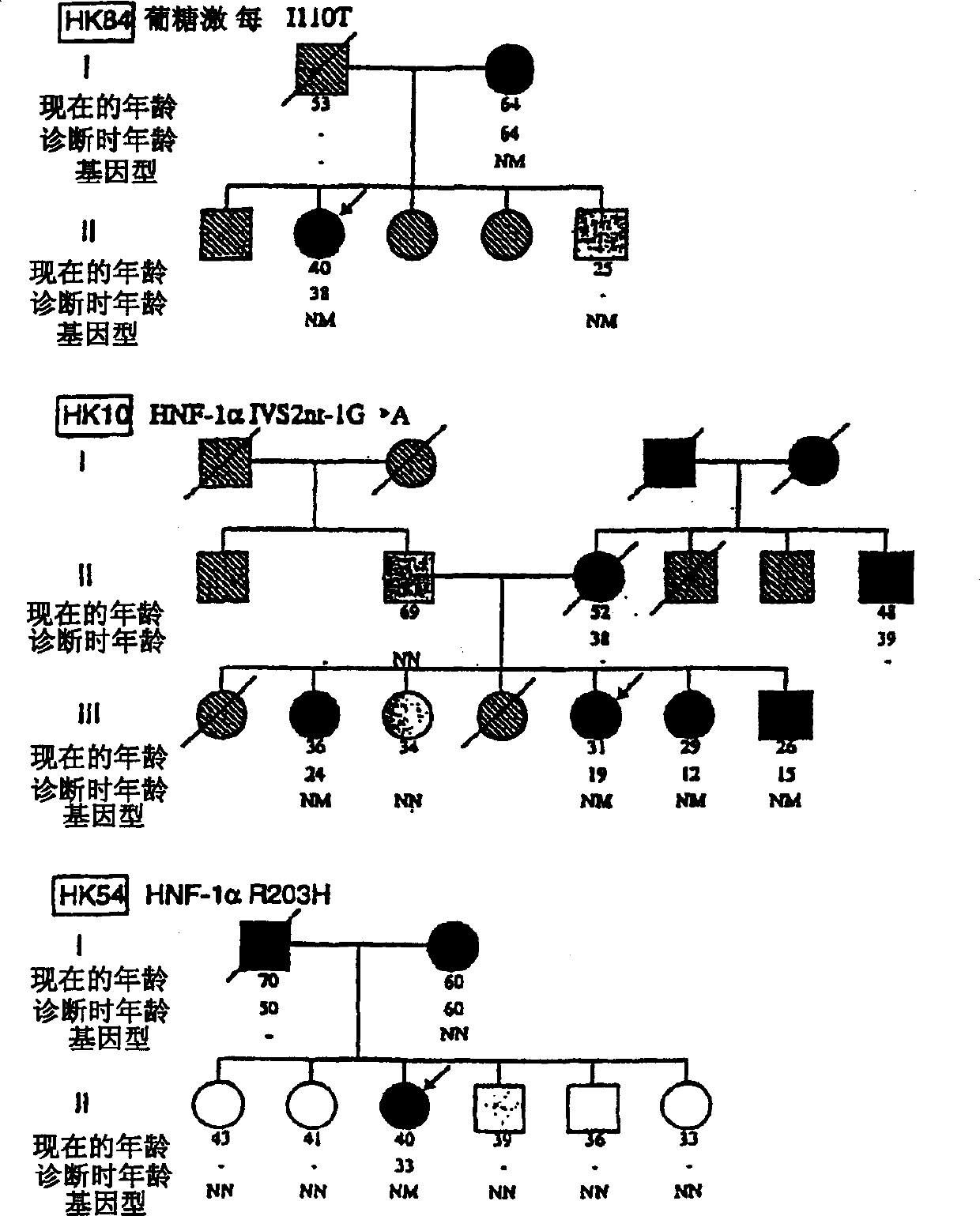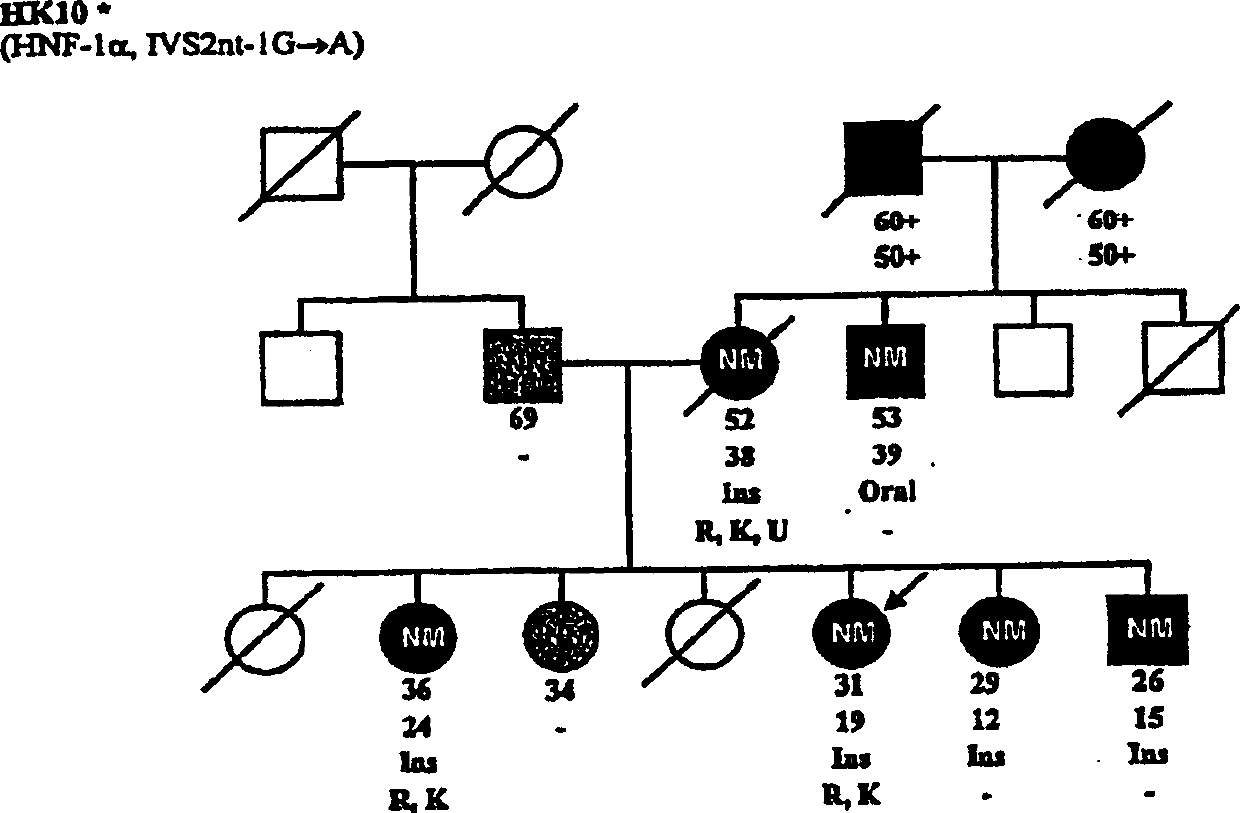Method for estimating danger of diabetes typ B developed in the human species of Chinese bloodline and composition
A technology for type 2 diabetes and population, applied in the direction of sugar derivatives, chemical instruments and methods, biochemical equipment and methods, etc., can solve the problems of non-disclosure
- Summary
- Abstract
- Description
- Claims
- Application Information
AI Technical Summary
Problems solved by technology
Method used
Image
Examples
Embodiment 1
[0065] Identification of glucokinase and hepatocyte nuclear factor 1α genes in Chinese patients with premature type 2 diabetes mellitus / MODY
[0066] This example exemplifies mutations in the glucokinase and hepatocyte nuclear factor 1α and HNF-4α genes identified in a group of Chinese patients. Mutations in the glucokinase and HNF-1α genes are relatively common in Chinese patients with early-onset type 2 diabetes, and they account for approximately 3% and 5% of current Chinese patients with early-onset type 2 diabetes, respectively.
[0067] Trial Design and Methods
[0068] subjects
[0069] This study group included 92 unrelated patients (age 34 ± 5 years (mean age ± SD) range 18-40 years, 30 males, 62 females) who were diagnosed with type 2 diabetes before the age of 40 and had Positive family history (at least 1st level associated with type 2 diabetes). The mean age at diagnosis was 30 ± 5 years (age range 16-40 years). Thirteen (14%) patients met the minimum criter...
Embodiment 2
[0172] Mitochondrial DNA A3243G mutation in early or late type 2 diabetes mellitus in Hong Kong Chinese
[0173] This example exemplifies the widespread prevalence of the A3243G mutation in mitochondrial DNA among Chinese in Hong Kong, manifested in a large number of type 2 diabetics at different ages at diagnosis and clinical phenotype.
[0174] Trial Design and Methods
[0175] subjects
[0176] The experimental group consisted of 906 unrelated type 2 diabetic patients diagnosed according to the 1985 WHO (World Health Organization, 1985) criteria. This group included four groups of patients based on age at diagnosis and the presence or absence of a family history of diabetes. Groups 1 and 2 included 219 and 128 patients, respectively, who were younger at diagnosis (≤40 years), with family history of diabetes in group 1 and no family history of diabetes in group 2. Groups 3 and 4 included 211 and 348 patients, respectively, with older age at diagnosis (>40 years old) in gr...
Embodiment 3
[0238] The role of amylin gene S20G mutation in early-onset type 2 diabetes mellitus and regulation of cholesterol metabolism in Chinese
[0239] This example exemplifies the distribution of the amylin gene S20G mutation in Hong Kong Chinese with and without type 2 diabetes, and its impact on β-cell function and metabolic profile. These data are consistent with the conclusion that the S20G mutation in the amylin gene leads to the early onset of type 2 diabetes, and it is also consistent with the conclusion that it may affect fat metabolism in the Chinese population.
[0240] Trial Design and Methods
[0241] subjects
[0242] This study was approved by the Clinical Research Ethics Committee of The Chinese University of Hong Kong. Consent was obtained from each participant. For the study, 227 early-onset and 235 late-onset type 2 diabetics (defined as age at diagnosis ≤40 and >40, respectively), and 126 non-diabetic subjects (defined as fasting plasma glucose 3+) or persiste...
PUM
 Login to View More
Login to View More Abstract
Description
Claims
Application Information
 Login to View More
Login to View More - R&D
- Intellectual Property
- Life Sciences
- Materials
- Tech Scout
- Unparalleled Data Quality
- Higher Quality Content
- 60% Fewer Hallucinations
Browse by: Latest US Patents, China's latest patents, Technical Efficacy Thesaurus, Application Domain, Technology Topic, Popular Technical Reports.
© 2025 PatSnap. All rights reserved.Legal|Privacy policy|Modern Slavery Act Transparency Statement|Sitemap|About US| Contact US: help@patsnap.com



